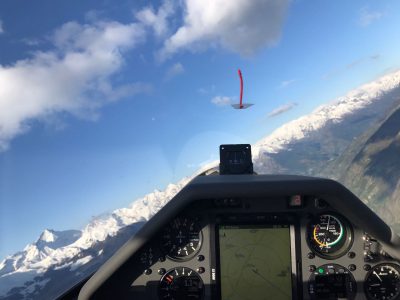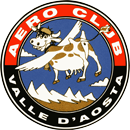Congrats, Alex Busca: 1,213.63 km!!!
Congrats, Alex Busca: 1,213.63 km!!!
Wave soaring is anything but straightforward. It starts with takeoff, where the strong winds on the ground (often not aligned with the runway in Aosta) create serious problems for both the tow pilot and the glider pilot; in order to reach the calm of the laminar wind that characterises the wave, we have to battle against powerful rotors that create violent turbulence and considerable physical discomfort. In these conditions, most pilots fly locally at their own airport: travelling around without the adequate technical expertise is really not recommended. Downwind positions and violent downdraughts can cause considerable altitude to be lost in a very short time; patience and skill are necessary to fly safely and enthusiastically.
Today the wind is right! Northwesterly with increasing intensity at altitude: optimal conditions for the tricky task of wave flying.
The day starts bright and early for AeC Valle d’Aosta’s three specialist wave flyers, Alex Busca, Giacinto Giorgio and Enrico Berthod: at 06.30am, they are all at the airport to open the hangars and assemble Alex’s Ventus-2cxa together with our very helpful president, Mr Attilio. However, simply putting together the glider is not enough…to fly fast you have to load water ballast into the special wing tanks, but with the icy temperatures expected at altitude, the water will freeze and cause irreparable damage to the glider. A percentage of “glycol” is therefore added to the water to stop it from freezing. This will be collected in special bins at the end of the flight so it can be reused.
Takeoff is scheduled for 08.00am.
Unfortunately, for gliders to fly they need a plane that can tow them up to a certain height, and finding a pilot to tow them on Easter Sunday isn’t always an easy task. AeC Valle d’Aosta has the good fortune of being able to count on a staff of extremely helpful “tow pilots”, above all the legendary Paolo Meneghini. Paolo is there right on time, and at 08.00am the Ventus D-4670 takes off from Aosta Airport. Giacinto and Enrico will follow at intervals of 10 minutes each.
The tow – first using ridge lift in Blavy, then in the rotors in the centre of the valley, and finally in wave – is quite straightforward, and Alex reaches 4,640 metres after around 25 minutes. From here, he begins his “ride” of 10 hours and 43 minutes that will lead him to complete a flight of 1.213,63 km OLC at an average of over 114 km/h, thus beating the Aosta Valley record of 1,120 km set back in 1998 by Giacinto Giorgio.
This sensational performance takes our Alex to the top of the OLC Alps 2017, and CID (Italian Distance Championship) Open class 2017 rankings.
As for our other two top pilots, Giacinto Giorgio and Enrico Berthod – the latter on his return after some time out – they logged two wonderful flights of 718,70 km e 749,03km.respectively.


 Italiano
Italiano English
English Deutsch
Deutsch Español
Español